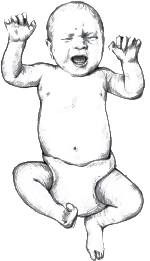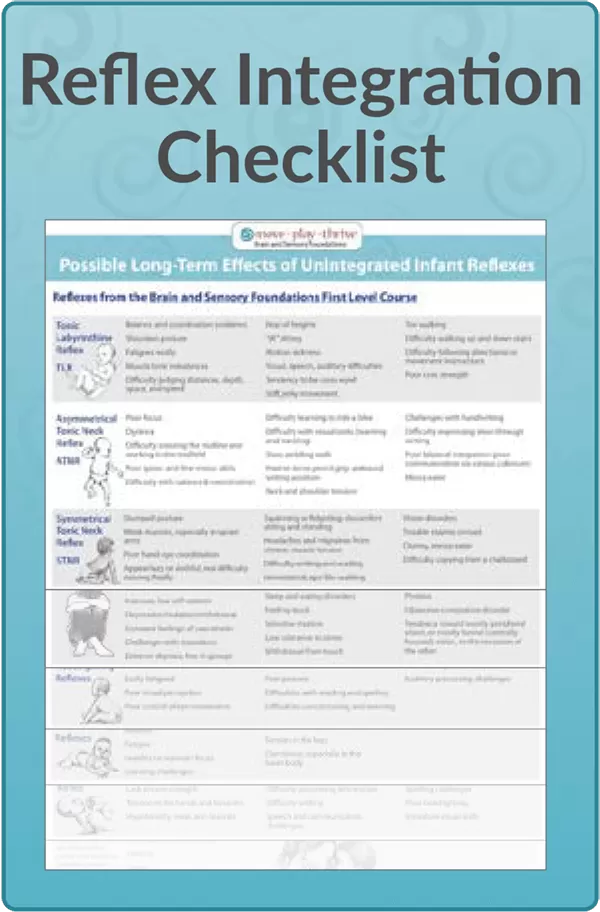Moro Reflex
 The Moro Reflex is essential for the development of sensory processing and emotional regulation. Moro reflex integration promotes calm sensory processing, emotional regulation, core strength, stamina, balance, and health. The Moro reflex may be exceptionally helpful for volatile, anxious, and highly sensitive individuals because it calms the fight-or-flight response and allows the neuro-sensory-motor systems to mature.
The Moro Reflex is essential for the development of sensory processing and emotional regulation. Moro reflex integration promotes calm sensory processing, emotional regulation, core strength, stamina, balance, and health. The Moro reflex may be exceptionally helpful for volatile, anxious, and highly sensitive individuals because it calms the fight-or-flight response and allows the neuro-sensory-motor systems to mature.
The Moro reflex, sometimes called the infant startle reflex, is an automatic reaction to a sudden change in sensory stimuli. An abrupt change of any kind (bright light, change in body position, temperature, loud noise, intense odor, touch etc.) can trigger the Moro Reflex.
When the Moro reflex is activated in an infant, the baby’s arms and legs open rapidly upward and away from the body. At the same time there is a quick intake of breath, then a momentary freeze of the arms and legs in the outward position. The arms and legs then return to the normal flexed posture of the infant, and the breath is released, often with a cry.
The Moro reflex is a response to a perceived threat and creates instant arousal of the baby’s survival system, or “fight or flight” response. It is also the baby’s instinctual response to summon a caregiver.
The following physiological responses occur with activation of the Moro Reflex:
- Release of stress hormones, adrenaline and cortisol
- Increase in breathing rate, shallow breathing
- Increased heart rate and blood pressure
- Blood moves towards the limbs, away from the brain and digestive organs
Ideally, the Moro reflex emerges in the womb by the end of the first trimester and is integrated by 4 months of age. As with all primitive reflexes, even after integration it can be re-activated later in life due to injury or stressful events, putting the individual back into a state of “fight or flight”.
Possible Long-Term Effects of a Retained Moro Reflex:
- ADHD
- Sensory processing disorder or overwhelm
- Sleep disturbances, difficulty settling down to sleep
- Easily triggered, reacts in anger or emotional outbursts
- Shyness
- Poor balance and coordination
- Poor stamina
- Motion sickness
- Poor digestion, tendency towards hypoglycemia
- Weak immune system, asthma, allergies and infections
- Hypersensitivity to light, movement, sound, touch & smell
- Vision/reading/writing difficulties
- Difficulty adapting to change
- Cycles of hyperactivity and extreme fatigue
- Easily distracted, difficulty filtering out extraneous stimuli
- Difficulty catching a ball
- Difficulty with visual perception
- Tires easily or is irritable under fluorescent lighting
- Amphibian Reflex
- Asymmetrical Tonic Neck Reflex
- Birth and Bonding
- Crawling Reflexes
- Crossed Extensor Reflex
- Facial-Oral Reflexes
- Fear Paralysis Reflex
- Feet Reflexes—Plantar & Babkinski
- Foot Tendon Guard
- Hand Reflexes—Grasp, Palmar, and Babkin
- Headrighting Reflexes
- Infant Torticollis
- Landau Reflex
- Moro Reflex
- Parachute Reflex
- Pull-to-Sit Reflex
- Spinal Galant Reflex
- Spinal Perez Reflex
- Symmetrical Tonic Neck Reflex
- Tonic Labyrinthine Reflex
Sources
Blomberg, H. (2015). The rhythmic movement method: A revolutionary approach to improved health and well-being. Lulu.com.
Goddard Blythe, S. (2023). Reflexes, movement, learning & behavior. Analysing and unblocking neuro-motor immaturity. Hawthorn Press.
Goddard Blythe, S. (2014). Neuromotor immaturity in children and adults: The INPP screening test for clinicians and health practitioners. John Wiley & Sons.
Masgutova, S. (2007). Integration of infant dynamic and postural reflex patterns: Neuro-sensory-motor and reflex integration method [Training manual].
Taylor, M., Chapman, E., & Houghton, S. (2004). Primitive reflexes and attention-deficit/hyperactivity disorder: Developmental origins of classroom dysfunction. International Journal of Special Education, 19(1), 23-37.


